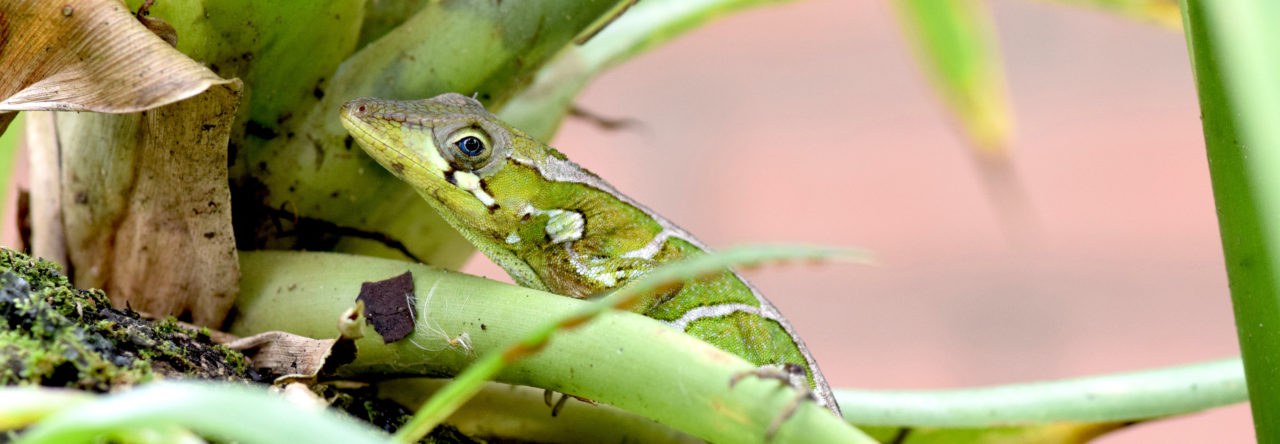
Anolis bicaorum from Utila, Bay Islands, Honduras. Photo by J. Losos.

Will global warming allow the blue-headed anole, A. allisoni, to move into the forest in the Bay Islands? This individual was photographed on Roatan by J. Losos.
Climate warming is a sad reality that environmentally defines our era. Over the next century, conservative estimates suggest that air temperatures will rise about 3° C. One imperative in research is to try to understand how reptiles, whose physiology is tightly linked to thermal environment, are going to be impacted by these increasing temperatures. During a symposium honoring Ray Huey, a leading biologist (and an anologist, to boot!), Michael Logan of Dartmouth College gave a talk on how small-scale estimates of thermal variation, rather than weather stations, yield interesting and perhaps counterintuitive results for how tropical lizards will be impacted by hotter temperatures. Predictions of potential impact to date rely heavily on temperature data gathered from weather stations – those provide a resolution of one square kilometer. For small reptiles, like tropical anoles, he argues that we need a finer resolution. To this end, Logan launched several operative temperature devices (sensors that perceive temperature as a lizard would, rather than just air temperature) on Cayo Mayor and Utila, which are islands in the Bay Island Archipelago in Honduras. We’ve discussed the anoles of the Bay Islands here on our blog before. On Cayo Mayor, Anolis lemurinus is found in the closed-canopy forest, while the blue-headed lizard, A. allisoni is found in more open habitats. A close relative of A. lemurinus, Anolis bicaorum, is found throughout Utila. Because closed-canopy forests are more thermally homogenous (less variation in available temperatures due to less access to sun and shade patches), the expectation is that, under a scenario of climate warming, the open habitat species A. allisoni should be able to invade A. lemurinus‘ habitat. Logan says that A. allisoni will not invade the forest habitat, although the details of the analysis suggest to me that they might. From what I saw, increasing temperatures in the forest should allow A. allisoni to invade the newly available warm habitat. He does find that A. lemurinus should experience a loss in potential daily activity hours because of increasing temperatures, putting this species at risk. The common species (A. bicaorum) will actually experience more hours of activity and likely benefit, at least in the short term, from increased temperatures. Logan concludes that more micro-scale measurements provide the appropriate resolution for studies of thermal performance in lizards, and will be the wave of the future.
 Nonetheless, I still can’t help wonder, where are the anole biogeographers? You can’t look through a text on island biogeography, species area curves or adaptive radiation without finding a dewlap. So the question is, are people not doing anole biogeography anymore? This isn’t the case, so it can only be that either the IBS isn’t on the radar, or people choose not to go. Either way, you’re missing out on a great meeting – it’s an excellent opportunity for the anole research community to radiate and reach a slightly different audience.
Nonetheless, I still can’t help wonder, where are the anole biogeographers? You can’t look through a text on island biogeography, species area curves or adaptive radiation without finding a dewlap. So the question is, are people not doing anole biogeography anymore? This isn’t the case, so it can only be that either the IBS isn’t on the radar, or people choose not to go. Either way, you’re missing out on a great meeting – it’s an excellent opportunity for the anole research community to radiate and reach a slightly different audience.





 Although Anole Annals is devoted to all things anoline, we try not to be too parochial. In particular, when fascinating items appear in print or cyberspace on other lizards, we try to report them here, especially if they have some relevance to matters anole.
Although Anole Annals is devoted to all things anoline, we try not to be too parochial. In particular, when fascinating items appear in print or cyberspace on other lizards, we try to report them here, especially if they have some relevance to matters anole.





